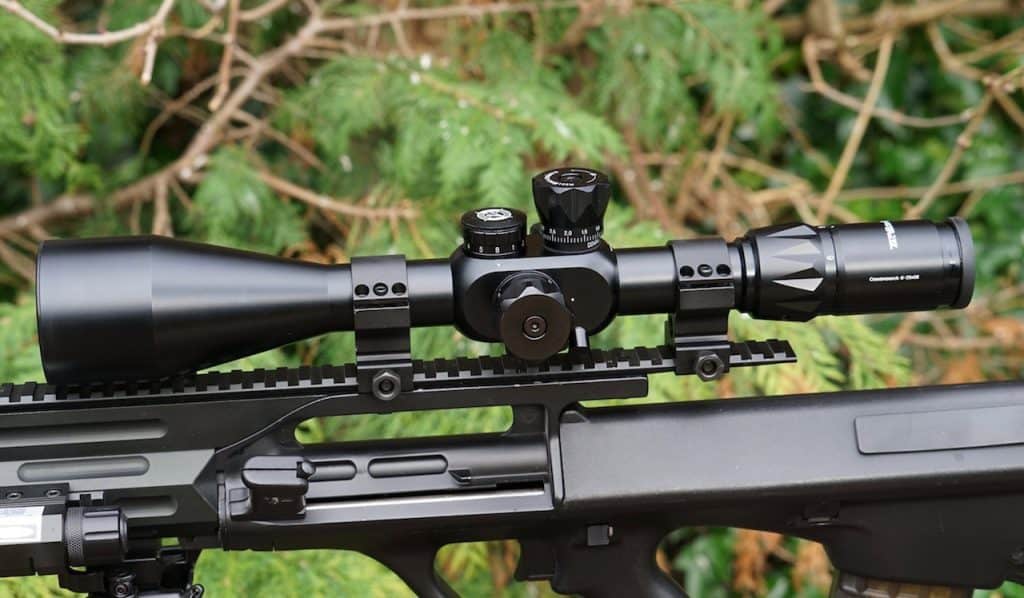Most people who own scopes are fairly familiar with adjustments made with the windage and elevation knobs. The elevation knob is on top of the scope and moves the reticle up and down, while the windage knob is generally on the right side of the scope and moves the reticle left and right. Uh-oh, you have a third knob on the left side of the scope. This is your side focus. What is a side focus on a scope? Allow me to introduce and explain the side focus or parallax adjustment knob.
Parallax
Parallax is when you look through your scope and focus on your target and it appears that the reticle is moving or floating around rather than staying on target. You may think that this is happening because you have moved your head slightly, but that shouldn’t really affect the placement of your reticle. The parallax adjustment knob allows you to focus your reticle on the correct focal plane so that you are not affected by parallax and can solidly place the reticle on target.
Normally, parallax only affects shooters at long range distances, so many times when parallax is experienced, shooters will associate the floating reticle with a problem with the scope or a problem that they themselves can’t seem to hold still. This is especially true of shooters who have very little experience with the parallax adjustment. It can save your hunt, though compared with the windage and elevation knobs, it is hardly ever used.
Testing your parallax on the range is simple, and you want to mark or chart where your parallax setting should be for certain yardages so that you don’t have to search for a perfect adjustment in the field where your rifle will be more unsteady. Using a bobble-head technique, looking through the scope and adjusting the parallax until the reticle doesn’t move anymore is pretty much a painless, foolproof way to test this.
Focal Plane
Generally, when talking about the focal plane on a scope, you are talking about the first or second focal plane. This is not really what we’re talking about here. We’re talking about the reticle in relation to your eye. When dealing with parallax, it’s important to get the reticle on the same focal plane as the target. Meaning, you need to be seeing the reticle on the target, not just pointing at the target.
For example, if you pick an image across the room and cover it with your thumb, then move your head around, your thumb will be all over the place, and not where you placed it on the image. It is not on the same focal plane. Now, have a friend go up and place their thumb on the image. Now, whenever you move your head the thumb stays in the same place on the image. It is on the same focal plane.
This is why you do not have parallax issues with a red dot. You can actually place the reticle on the target. Normally with scopes though, you cannot actually place the reticle on the target, so this is where the side focus parallax knob comes in. It will focus your reticle and zoom it in so that it is like it is on the same focal plane with the target.
Other Parallax Adjustment Locations And Pros And Cons
With parallax adjustments, there are two main types for scopes: the side focus adjustment and the adjustable objective. The side focus it that extra adjustment knob on the left side of your scope. The adjustable objective is an adjustable ring around your objective lens. There are pros and cons to each.
The side focus adjustment is better for tactical or hunting applications where your distance is unknown and may need to be changed quickly. It is easier to adjust this knob as it is close up and operates from a side twist. The problems with the side focus are that they are not always the most accurate as far as the factory yardage markings go, and often you need to shoot with them and chart the actual adjustment distances yourself. Also, these scopes tend to be heavier and a bit more on the expensive side.
The adjustable objective is better for fixed shooting applications like competitions, where you will know your shooting distance before-hand and can adjust the parallax only once and leave it. These adjustments tend to be a bit more accurate. They also make the scope lighter than the side focus knobs and tend to be less expensive. The problem with these are that they are more difficult to adjust as you have to reach way out in front of you and rotate the dial around the objective lens. You definitely don’t want to be doing this while hunting or in a tactical situation.
Overall, I believe that the side focus parallax adjustment option is the more popular choice of the two. It’s just easier to not have to move off target to adjust your parallax.
Conclusion
I hope that you now have a fairly good idea of what a side focus is on your scope. The whole parallax thing can be confusing, and if you’re not used to it, you may not even be recognizing when parallax is a problem. Once you do understand and recognize that you’re having a parallax issue, using that side focus adjustment can be a life-saver and a game changer. You certainly don’t want your reticle bouncing all over the place while you’re trying to execute the perfect 800-yard shot!
Now that you know what parallax is, how to recognize it, test for it, and adjust for it, you should take your scope out and play around with it. Figure out where your parallax adjustment needs to be to cure the problems while practicing, then go out and have a flawless shooting experience when it counts.
If you enjoyed this article you’ll probably like these:



